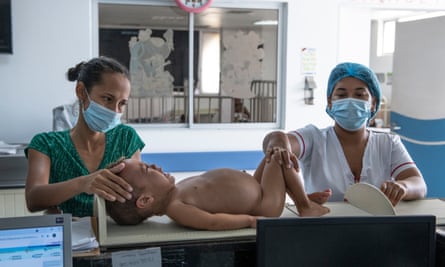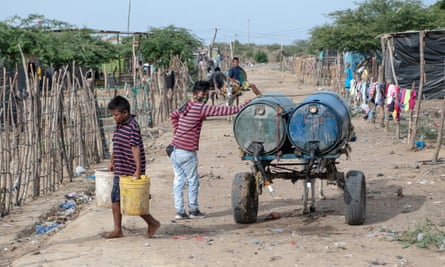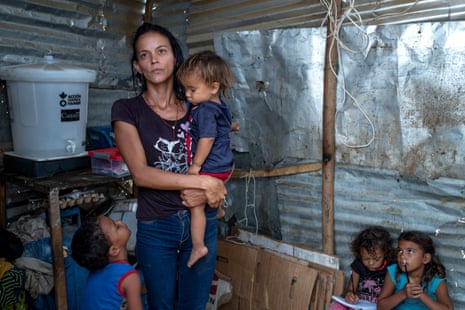A seemingly endless lake of cardboard and tin shacks surrounds the perimeter of a former airport runway in Colombia’s desert-like city of Maicao. Known locally as La Pista, the area is home to more than 2,000 families, and is one of 44 informal settlements to have emerged around the city in the past two years.
The old airport has become a landing strip for desperate migrants and bi-national indigenous Wayuu people fleeing the economic and political crisis in Venezuela, where the basic essentials of life are hard to come by.
Maicao is in La Guajira, the most northern region of Colombia, and sits on the border with Venezuela. It is the second busiest entry point for migrants after the main border city of Cúcuta.
The stench of urine fills the air inside the roasting hot tin shack where Elaine Rojas lives with her family. There is no toilet so the family of six go where they can. Rojas, 27, came from the Venezuelan city of Maracaibo four years ago in search of a decent life for her children.
Her frailty is a sign of malnutrition; food was in short supply in her homeland and has been since she arrived in Colombia.
“It’s not better [than Venezuela] but at least we have some food, though sometimes we don’t have enough,” says Rojas. “When it rains it’s awful, the whole place floods.”

Rojas and her husband, who both survive by recycling plastic, built their hut themselves, starting out with plastic bags and pieces of wood before getting some corrugated iron. As no running or drinkable water is available in La Pista, everyone relies on water-sellers who charge a fee to distribute untreated barrels of it, carried between the homes on donkeys.
Many people in Maicao are suffering from malnutrition. Organisations such as Save the Children and Action Against Hunger are supporting families La Pista but the majority of families still eat only one meal a day, mostly made from flour but occasionally rice. Few can afford meat, fruit and vegetables. One tomato can cost an unaffordable 800 pesos (15p).
Such a diet is one of the main causes of malnutrition, says Mabis Mercado, who is in charge of looking after migrant patients at Maicao’s main hospital. She believes there are about 8,000 people in La Pista, and says cases of malnutrition have shot up since last year. The hospital dealt with 152 cases of chronic malnutrition in 2020; 68 among Venezuelans and 25 among indigenous communities.
“Those most affected are the indigenous populations,” Mercado says. “The water in La Pista is horrible; it causes a lot of intestinal problems, which add to the issue of malnutrition.”
In 2018 doctors started seeing more serious cases of malnutrition as Venezuela’s crisis intensified, she says. The pandemic has made the precarious situation even worse.

“Last year it was really critical because a lot of the migrants have informal jobs. With the pandemic lockdown, they couldn’t do anything, everything was closed down, so many people were going hungry, unable to afford food,” Mercado says. “We found newborns with malnutrition and children who, because of lack of access to milk … started to fall into malnutrition too.”
The hospital are giving out supplements. “But we’ve run out. We only had supplies for three months,” she says.
Data from Colombia’s authorities says 51,361 migrants live in Maicao, but Mercado and others working on the ground told the Guardian that these numbers were a conservative estimate. They say it is almost impossible to control migration, due to the many informal and dangerous border crossings, known as trochas, which are used to smuggle weapons, medicine and petrol.
“There are 180 trochas, and no control,” says Mercado. “It’s difficult to regulate and the data is not accurate.”
Inside the hospital, Rosa Primera, 29, sits with her 18-month-old son, whose light-coloured hair is a clear sign of malnutrition. Primera has been in Maicao for three months and has the same story as most: “I left [Venezuela] because of the crisis,” she says. “I didn’t have money for food.”
Dr Alberto Galue, who heads the children’s ward at Maicao’s hospital, says the malnutrition levels are “very serious … We are overwhelmed.”

In May 2019, the UN refugee agency, UNHCR, set up its first camp in Colombia, providing a temporary respite. In the last six months, though, dozens more makeshift dwellings have sprung up around the UN camp.
UNHCR’s Colombia representative, Jozef Merkx, says the agency is working with the authorities to address the “urgent needs in various informal settlements with many refugees, migrants and host families”.
“A large part of the population in the new, informal settlements are of Wayuu origin, mostly coming from the Venezuelan side of the border,” he says.
Wayuu people make up 56.4% of the overall population in La Guajira, and they do not recognise the border between Colombia and Venezuela.
One Wayuu girl who crossed into Colombia from Venezuela says she had lost two babies to malnutrition.
“They were sick. They had diarrhoea and vomiting and I had no resources,” says Yulexi del Carmen, 16, in her Wayuunaiki language, while her cousin translates into Spanish. “One died after a month, and the other when he was a year old.”

Del Carmen and her family were preparing rice for lunch when the Guardian visited. In the evening they drink chicha, a traditional beer made from fermented maize. Their plastic water barrel was empty as they had run out of money.
Osmer José, a 20-year-old water-seller, says being in La Pista is “like being in Venezuela but money goes further”. Water costs 3,000 pesos ( 60p) a day for those who can afford it.
Many Venezuelans live in similar corrugated-iron shacks in Maicao’s city centre, including 33-year-old Ana Josefina Gutiérrez, from Los Puertos de Altagracia, over the river from the bigger city of Maracaibo, a few hours drive away. She has lived in precarious conditions here for about 18 months.
When she was pregnant she was penniless and at times had to sleep on the street with two young children in tow. “I didn’t know what to do,” says Gutiérrez, who is at a Maicao health clinic with her baby son. “I slept outside. I didn’t eat well. Sometimes I didn’t eat at all for two days.
“He had malnutrition because I was going through a rough time and I didn’t have anything to give him,” she says. “Never in my life did I think I’d be living like this.”
Gutiérrez, who is diabetic, received some emergency funds from Save the Children and has been able to get herself off the street and into basic housing. She says it costs her about 7,000 pesos (£1.35) a day to get by.

Her only furniture in the one-room shelter is a second-hand foam mattress and a crib. The home is made of tin and is surrounded by rooms housing other Venezuelans. The metal makes for a sweltering interior in daytime, but at least she is safe here for now. Her funds are likely to last for three months, she says.
Colombia’s border with Venezuela recently reopened, after closing in March 2020 to curb the spread of the pandemic. More people have already started to flood across, says Mercado.
As September’s rainy season approaches, concern is growing for the people living in La Pista. Their cardboard and tin houses will undoubtedly flood, and water will be further contaminated, causing more illness.
“I’ve asked God for no rain this year,” says Mercado. “It’s already been so tough for people, with the pandemic. Their homes will be destroyed.”
